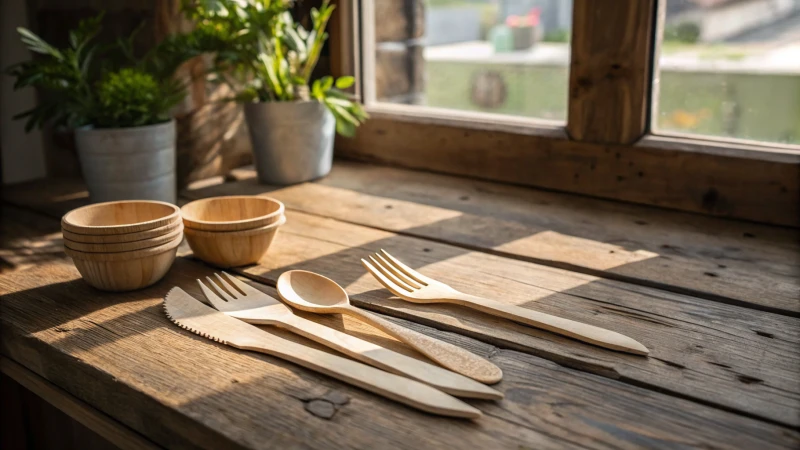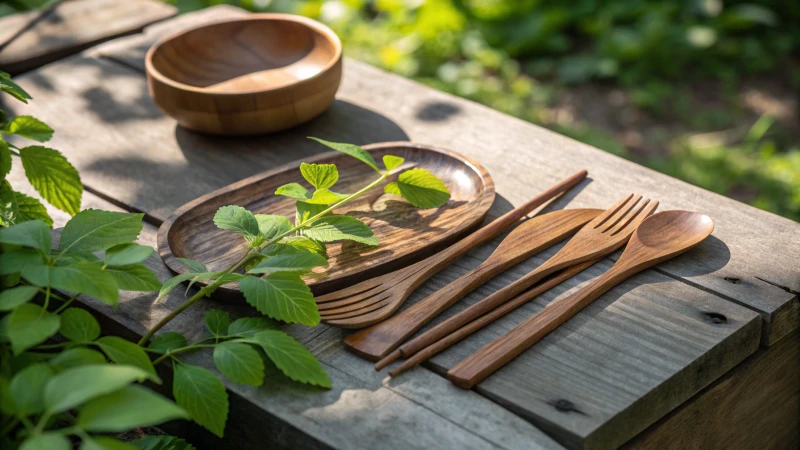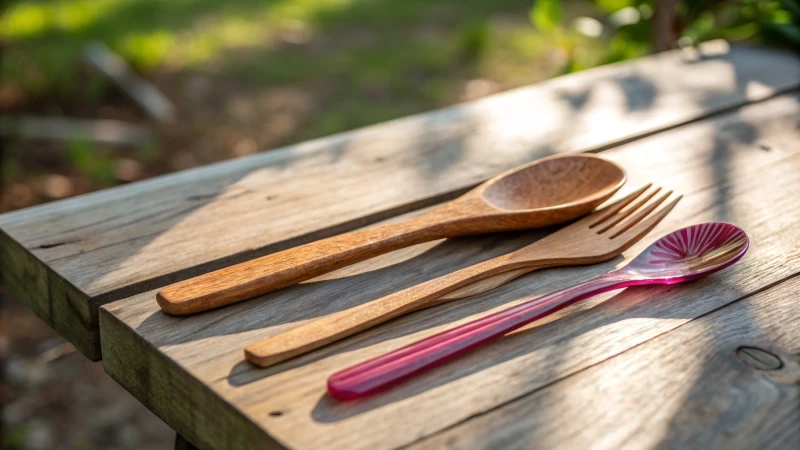
Imagine standing on a beach, the ocean waves lapping at your feet, knowing your choices helped keep it clean.
Switching to disposable wooden cutlery can dramatically cut down on plastic pollution and ocean waste. These biodegradable alternatives break down naturally, reducing our environmental footprint and helping protect marine ecosystems.
But let's be honest, how effective is this switch in the grand scheme of sustainability? I remember the first time I swapped plastic for wooden cutlery at a family picnic. Not only did it feel right, but it also sparked conversations about sustainability. This article explores the environmental impact of wooden cutlery, how industries are adopting it, and the hurdles in making this switch widespread.
Wooden cutlery is biodegradable.True
Wooden cutlery decomposes naturally, reducing environmental impact.
Plastic cutlery decomposes faster than wooden cutlery.False
Plastic takes hundreds of years to decompose, unlike wood.
How Does Wooden Cutlery Benefit the Environment?
Switching to wooden cutlery is like giving Mother Earth a much-needed hug, making dining greener one fork at a time. Let me tell you why.
Wooden cutlery is environmentally friendly because it's biodegradable, reducing plastic waste, and is made from renewable resources. It breaks down quickly compared to plastic, decreasing landfill waste and conserving resources, thus providing a more sustainable choice.

Biodegradability and Waste Reduction
Imagine a world where our everyday utensils don't outlive us. I remember the day I ditched plastic forks for wooden ones. It felt like a small, powerful rebellion against the sea of plastic that threatens our planet. Unlike their plastic counterparts, which linger for centuries, wooden cutlery decomposes naturally in just a few months. This small change significantly reduces landfill clutter and soil contamination while protecting wildlife from ingesting harmful plastics.
| Feature | Wooden Cutlery | Plastic Cutlery |
|---|---|---|
| Decomposition Time | Months | Hundreds of Years |
| Renewable Source | Yes | No |
| Wildlife Impact | Low | High |
Sourcing from Renewable Resources
When I first learned about wooden cutlery being crafted from fast-growing trees like birch and bamboo, it was like discovering a secret path to sustainability. These materials are harvested responsibly, with new trees planted to replace those used. This cycle is a far cry from the destructive processes tied to fossil fuel extraction for plastics. Plus, wooden cutlery often requires less energy to produce.
Embracing materials like bamboo1 not only supports sustainable forestry but also helps reduce our carbon footprint.
Reduction of Carbon Footprint
I once stumbled upon a fact that stuck with me: the carbon footprint of wooden cutlery is markedly lower than that of plastic utensils. The production of plastic involves intense energy consumption and emits tons of greenhouse gases. Conversely, crafting wooden cutlery requires simpler, less energy-intensive processes.
Moreover, as trees grow, they absorb carbon dioxide, playing a crucial role in mitigating climate change. By choosing wood products, we support forest management practices that enhance this natural carbon sink.
Natural Aesthetic and Versatility
One of my favorite things about wooden cutlery is its natural charm—perfect for everything from a casual picnic to an elegant dinner party. Its versatility is a huge draw for businesses in the hospitality industry2, offering them a way to enhance their brand image with a touch of sustainability.
Wooden cutlery can also be easily customized with logos or designs, adding a personal touch without the need for additional chemical processes.
While I could go on about the numerous benefits, these highlights show how choosing wooden cutlery over plastic supports waste reduction and resource conservation, aligning with eco-friendly values cherished by many today.
Wooden cutlery decomposes within a few months.True
Wooden cutlery is biodegradable, breaking down naturally in months.
Plastic cutlery is made from renewable resources.False
Plastic cutlery is derived from fossil fuels, not renewable resources.
Why Are Industries Turning to Wooden Cutlery?
Imagine a world where every meal feels like a small step towards saving the planet.
Industries like food service, healthcare, and retail are increasingly adopting wooden cutlery to reduce environmental impact. This shift is driven by regulatory pressures, eco-conscious consumer preferences, and the pursuit of sustainable business practices.

Food Service Industry Embracing Change
I remember my first time seeing wooden cutlery at a local café. It felt refreshing, like discovering a hidden gem. This move is gaining momentum in the food service industry. Restaurants and cafes, driven by plastic bans and a growing demand for sustainable options, are swapping out plastic utensils for eco-friendly wooden cutlery3. Even fast-food giants like McDonald's are on board, showing that change is not only possible but inevitable.
| Restaurant Chains | Sustainability Initiatives |
|---|---|
| McDonald's | Replacing plastic cutlery |
| Starbucks | Implementing wooden stirrers |
This shift is doing more than just reducing plastic waste; it’s drawing in diners who care about their environmental footprint, which, in turn, supports a greener future.
Healthcare's Sustainable Shift
In the healthcare sector, I’ve seen firsthand how crucial it is to align with strict health standards while embracing sustainability. Hospitals and clinics are now incorporating wooden alternatives4 like tongue depressors and stirrers into their operations. Dr. Lucas, a seasoned healthcare supply chain manager in Germany, shared how these solutions meet European safety standards without compromising ecological integrity.
Retail's Green Transformation
In retail, the shift towards sustainable products is palpable. I spoke with Zhang Wei, an eco-conscious retail buyer in China, who is passionately sourcing biodegradable wooden cutlery to replace traditional plastics. By prominently displaying these products, retailers aren’t just reducing their carbon footprints—they’re making a bold statement about their commitment to environmental responsibility.
As industries pivot towards wooden cutlery, they’re not just meeting regulatory demands but also resonating with eco-aware customers. It’s a strategic decision that enhances brand image while making a tangible contribution to our planet’s future.
McDonald's is replacing plastic cutlery with wooden ones.True
McDonald's has initiated the replacement of plastic utensils with wooden cutlery.
Healthcare facilities avoid using wooden alternatives.False
Healthcare facilities are adopting wooden alternatives like tongue depressors.
What Challenges Are Faced When Switching to Wooden Cutlery?
Embarking on the journey to replace plastic with wooden cutlery is exciting yet full of hurdles. Dive in with me as I share my experience navigating these challenges.
Switching to wooden cutlery poses challenges like increased costs, scarce availability, potential hygiene issues, and the need to educate consumers about its sustainability advantages.

Cost Implications
I remember the first time I decided to switch to wooden cutlery for my business. The sticker shock was real! It's no secret that wooden cutlery tends to be pricier than its plastic counterpart. Initially, I had to make some tough decisions about whether to absorb the extra cost or pass it on to my customers. Bulk purchasing was a strategy I considered, hoping for some savings, but it's a balancing act between cost and storage space.
| Cost Factors | Wooden Cutlery | Plastic Cutlery |
|---|---|---|
| Initial Cost | Higher | Lower |
| Bulk Purchase Savings | Available | Limited |
Availability and Supply Chain
Finding a reliable supplier was another adventure. Depending on where you are, wooden cutlery can be as elusive as a unicorn. I had to do my homework and establish relationships with trustworthy suppliers who promised quality without compromising on sustainability. Partnering with eco-friendly suppliers5 became essential, ensuring that the products met my standards and were ready when I needed them.
Hygiene Concerns
Hygiene was a topic of many sleepless nights for me, especially since I cater to sectors where safety can't be compromised. Understanding how wood treatment6 affects hygiene was crucial. It took a lot of research and discussion with experts before I felt comfortable with the products I chose. Ensuring that consumers feel safe using these products daily was equally important.
Consumer Education
Educating my customers about why this switch matters was perhaps the most rewarding challenge. It wasn't just about making the switch; it was about helping others see the bigger picture. Through transparent communication about the sustainability benefits7, I crafted campaigns that underscored the eco-friendly advantages of wooden cutlery. Highlighting aspects like biodegradability and resource conservation helped shift perceptions and foster acceptance among eco-conscious patrons.
Wooden cutlery is more expensive than plastic.True
Wooden cutlery has a higher initial cost compared to plastic.
Plastic cutlery is more eco-friendly than wooden cutlery.False
Wooden cutlery is biodegradable, unlike plastic, which is not.
Why Should We Choose Wooden Cutlery Over Plastic?
Imagine swapping your plastic forks and spoons for wooden ones and feeling that tiny, yet powerful connection to nature each time you dine.
Wooden cutlery is a fantastic eco-friendly choice over plastic due to its biodegradability, lower carbon footprint, and absence of harmful chemicals. By choosing wood, you're aligning with sustainable practices and helping reduce environmental impact.

Environmental Impact
Every time I pick up a wooden fork, I imagine the relief it brings to our overflowing landfills. Unlike plastic, which lingers for centuries, wooden utensils break down naturally within months. This simple switch helps reduce the burden on our planet and cuts down on the carbon emissions involved in plastic production. Seeing the stark difference between decomposition times—500 years for plastic versus 3-6 months for wood—always strengthens my resolve to choose wood.
| Material | Decomposition Time |
|---|---|
| Plastic | Up to 500 years |
| Wood | 3-6 months |
Health Considerations
I remember reading about BPA and phthalates in plastics and feeling a knot of worry for my family's health. These chemicals can seep into our food, posing serious health risks. With wooden cutlery, I feel peace of mind knowing it's free from such harmful additives. This makes it a safe choice, especially crucial in healthcare settings where health standards8 are high and risks must be minimized.
Aesthetic and Brand Alignment
In my experience working with hospitality brands, the charm of wooden cutlery can truly transform a dining experience. It offers a rustic elegance that resonates with brands dedicated to sustainability and aesthetics9. I've seen businesses engrave their logos onto these utensils, turning a meal into a memorable brand statement that whispers eco-friendliness.
Compliance with Regulations
Watching the world shift away from single-use plastics has been encouraging. Many countries are imposing bans, and by choosing wooden cutlery, businesses can stay ahead of these regulations while showcasing their environmental commitment. For example, European regulations10 are steering towards eliminating plastic waste, making wood not just an option but a necessity.
Cost-Effectiveness and Supply Chain Reliability
Though wooden cutlery might seem pricier at first glance, I've learned it pays off in the long run. Its positive impact on brand perception can boost business. Plus, many suppliers provide competitive rates and consistent quality, ensuring a steady supply for large operations—a crucial factor when you need reliability in bulk.
Wooden cutlery decomposes faster than plastic.True
Wooden cutlery decomposes in 3-6 months, while plastic takes up to 500 years.
Plastic utensils are free from harmful chemicals.False
Plastic often contains BPA and phthalates, which can leach into food.
Conclusion
Disposable wooden cutlery offers a sustainable alternative to plastic, reducing pollution and waste while being biodegradable, renewable, and supporting eco-friendly practices across various industries.
-
Bamboo is a fast-growing renewable resource with minimal environmental impact, making it ideal for sustainable products. ↩
-
Using eco-friendly materials like wood enhances brand image and aligns with sustainability goals in hospitality. ↩
-
Explore how popular restaurants are implementing wooden cutlery to meet sustainability goals and attract eco-conscious customers. ↩
-
Learn about healthcare facilities incorporating wooden options to align with environmental standards while ensuring patient safety. ↩
-
Discovering reliable suppliers ensures consistent availability of sustainable products, helping businesses meet demand without compromising quality. ↩
-
Exploring wood treatment processes aids in selecting safe and hygienic cutlery options for various industries. ↩
-
Understanding sustainability benefits can help consumers appreciate the ecological advantages of switching to wooden cutlery. ↩
-
Understand the health risks associated with plastic cutlery and why wood is a safer choice. ↩
-
Explore how customizable wooden cutlery can enhance brand image and appeal. ↩
-
Stay informed on regulatory changes affecting plastic use in Europe. ↩

